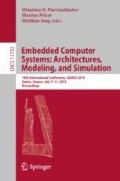Abstract
Energy consumption is one of the major challenges for the advanced System on Chips (SoC). This is addressed by adopting heterogeneous and approximate computing techniques. One of the recent evolution in this context is transprecision computing paradigm. The idea of the transprecision computing is to consume adequate amount of energy for each operation by performing dynamic precision reduction. The impact of the memory subsystem plays a crucial role in such systems. Hence, the energy efficiency of a transprecision system can be further optimized by tailoring the memory subsystem to the transprecision computing. In this work, we present a lean, low power, low latency memory controller that is appropriate for transprecision methodology. The memory controller consumes an average power of 129.33 mW at a frequency of 500 MHz and has a total area of 4.71 mm2 for UMC 65 nm process.
Access this chapter
Tax calculation will be finalised at checkout
Purchases are for personal use only
References
Malossi, A.C.I., et al.: The transprecision computing paradigm: concept, design, and applications. In: 2018 Design, Automation Test in Europe Conference Exhibition (DATE), pp. 1105–1110, March 2018
Rossi, D., et al.: Energy-efficient near-threshold parallel computing: the PULPv2 cluster. IEEE Micro 37(5), 20–31 (2017)
Weis, C., et al.: DRAMSpec: a high-level DRAM timing, power and area exploration tool. Int. J. Parallel Program. 45(6), 1566–1591 (2017)
Jung, M., et al.: ConGen: an application specific dram memory controller generator. In: Proceedings of the Second International Symposium on Memory Systems, MEMSYS 2016, pp. 257–267. ACM, New York (2016)
Bhati, I., et al.: Flexible auto-refresh: enabling scalable and energy-efficient DRAM refresh reductions. In: Proceedings of the 42nd Annual International Symposium on Computer Architecture, pp. 235–246. ACM (2015)
Liu, J., et al.: RAIDR: retention-aware intelligent dram refresh. In: Proceedings of the 39th Annual International Symposium on Computer Architecture, ISCA 2012, pp. 1–12. IEEE Computer Society, Washington (2012)
Jung, M., et al.: Approximate computing with partially unreliable dynamic random access memory - approximate DRAM. In: Proceedings of the 53rd Annual Design Automation Conference, DAC 2016, pp. 100:1–100:4. ACM, New York (2016)
Lucas, J., et al.: Sparkk: quality-scalable approximate storage in DRAM. In: The Memory Forum, June 2014
Liu, S., et al.: Flikker: saving DRAM refresh-power through critical data partitioning. SIGPLAN Not. 46(3), 213–224 (2011)
Jung, M.., et al.: Omitting refresh - a case study for commodity and wide I/O DRAMs. In: 1st International Symposium on Memory Systems, MEMSYS 2015, Washington, DC, USA, October 2015
Mathew, D.M., et al.: Using run-time reverse-engineering to optimize DRAM refresh. In: International Symposium on Memory Systems (MEMSYS17) (2017)
Jedec Solid State Technology Association. DDR3 SDRAM (JESD 79–3) (2012)
Cadence Inc.: Cadence® Denali® DDR Memory IP, October 2014. http://ip.cadence.com/ipportfolio/ip-portfolio-overview/memory-ip/ddr-lpddr. Accessed 18 Feb 2015
Synopsys, Inc.: DesignWare DDR IP (2015). http://www.synopsys.com/IP/ InterfaceIP/DDRn/Pages/. Accessed 18 Feb 2015
Fan, X., et al.: ESD protection circuit schemes for DDR3 DQ drivers. In: Electrical Overstress/Electrostatic Discharge Symposium Proceedings, pp. 1–6 (2010)
Yoo, C., et al.: A 1.8 V 700 Mb/s/pin 512 Mb DDR-II SDRAM with on-die termination and off-chip driver calibration. In: 2003 IEEE International Solid-State Circuits Conference, ISSCC 2003. Digest of Technical Papers, vol. 1, pp. 312–496, February 2003
Chen, S., et al.: An all-digital delay-locked loop for high-speed memory interface applications. In: Technical Papers of 2014 International Symposium on VLSI Design, Automation and Test, pp. 1–4, April 2014
De Caro, D.: Glitch-free NAND-based digitally controlled delay-lines. IEEE Trans. Very Large Scale Integr. (VLSI) Syst. 21(1), 55–66 (2013)
Micron: DDR3 SDRAM System Power Calculator, July 2011. Accessed 03 July 2014
Acknowledgment
The project OPRECOMP acknowledges the financial support of the Future and Emerging Technologies (FET) programme within the European Unions Horizon 2020 research and innovation programme, under grant agreement No. 732631 (http://www.oprecomp.eu). This work was also supported by the Fraunhofer High Performance Center for Simulation- and Software-based Innovation.
Author information
Authors and Affiliations
Corresponding author
Editor information
Editors and Affiliations
Rights and permissions
Copyright information
© 2019 Springer Nature Switzerland AG
About this paper
Cite this paper
Sudarshan, C., Lappas, J., Weis, C., Mathew, D.M., Jung, M., Wehn, N. (2019). A Lean, Low Power, Low Latency DRAM Memory Controller for Transprecision Computing. In: Pnevmatikatos, D., Pelcat, M., Jung, M. (eds) Embedded Computer Systems: Architectures, Modeling, and Simulation. SAMOS 2019. Lecture Notes in Computer Science(), vol 11733. Springer, Cham. https://doi.org/10.1007/978-3-030-27562-4_31
Download citation
DOI: https://doi.org/10.1007/978-3-030-27562-4_31
Published:
Publisher Name: Springer, Cham
Print ISBN: 978-3-030-27561-7
Online ISBN: 978-3-030-27562-4
eBook Packages: Computer ScienceComputer Science (R0)

